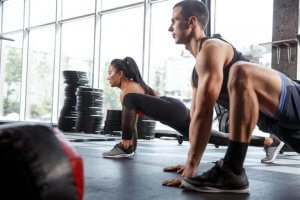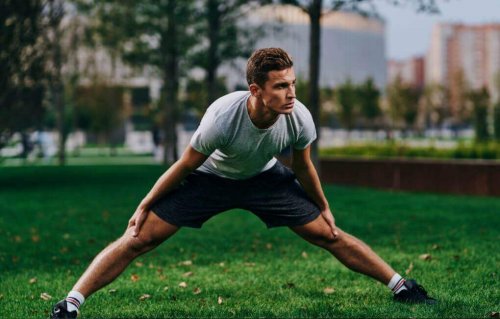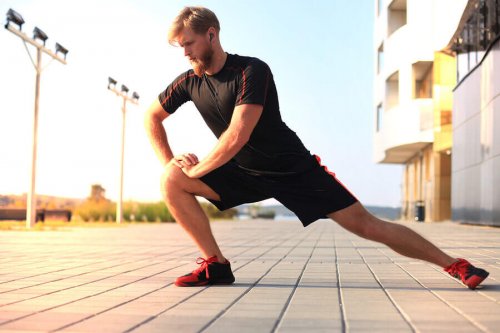The Benefits of Active Stretching Routines

The idea of stretching that most people have learned since childhood is actually not the best. The most popular style of stretching isn’t as physiologically effective as other types of stretching. The best and most effective style of stretching is called active stretching. Read on to learn about this improved way to stretch your muscles.
You might like: Practice Stretching at Home in Order to Stay Active
Traditional stretching
Most people are taught to stretch the posterior musculature of the leg by bending their backs and trying to touch their toes. Another well-known stretch is bringing the heel up to the buttocks to stretch out the quadriceps. Additionally, many people know about the stretch where you lunge to the side to stretch the adductors.
Well, it turns out that these types of stretches are actually passive stretches. In other words, they utilize external forces to stretch a muscle.
In the stretches mentioned above, gravity, your hands, and your body weight are working together to force a muscle to stretch without activating any muscle group related to the one you want to stretch. These exercises technically achieve their goal: to stretch the targetted muscle, but nothing more.
Active stretching
In contrast, active stretching respects the physiological movements of the body. When you execute any movement in everyday life, the main muscles contract and the opposite muscles- those that perform the opposite function – relax and the soft tissues that surround the joints are prepared. Everything happens in a controlled and balanced way.

When you do passive stretches, you’re simply artificially stretching a muscle or a muscular chain, without providing any other beneficial element.
For active stretching, you must contract the opposite muscle to the one you want to stretch. In this way, you create a stretch by bringing the origin and insertion of the muscle, the two extremes, farther away from each other.
In addition, you also help yourself to stretch by producing natural muscle relaxation by contracting the opposite muscle.
How to do active stretching
Using the example of adductor stretching, instead of simply leaning your body weight to the side, at the same time you have to exert yourself by lifting your leg up and to the side. Thus, you contract the muscles of the external part of the leg. This will help you to relax and stretch the internal one more easily.
In the case of the quadriceps, in addition to bringing your heel to your buttocks, it’s a good idea to contract the hamstrings. In other words, you have to actively press the heel against the buttocks.
There are also more complex active stretches that, in addition to the above, help to improve your stability and body position awareness. For example, you can use your core to help stretch the muscles of the lower limbs while keeping your back straight.
As always, the more exercise you do, and the more you demand from your body, the more complicated your workouts can be. In this case, you should ask a personal trainer or physical therapist to assist you with your progress. They’ll be able to show you the best and the most specific stretches for your individual case.
You might like: Static Stretching vs. Ballistic Stretching
Benefits of active stretching
With that said, the main benefit of active stretching is that you stretch the muscle in a more physiologically correct way. In addition, you better prepare your body to withstand the subsequent force and strain of your workout.
This is because, as you read above, you’re also activating the anatomical elements that surround the muscle. Thus, with active stretching, you’re also activating the joint capsule and the internal structures of the muscle that are between the muscle fibers and the tendons.

A static stretch is one in which the muscle is stretched gently, with a light or moderate demand. This is important in helping to prevent injury.
Therefore, it’s a good idea to perform active stretching before doing sports or working out. As a result, you’ll activate your body and your muscles instead of relaxing them.
Additionally, your body will be better prepared for exerting itself during your workout.
So do we stop passive stretching?
It’s not necessary to stop stretching the traditional way, but try to be more conscious of the movements you’re making. If you want to relax your body, it’s better to perform passive stretches.
Therefore, at the end of your workout session, a more passive stretching style is much more useful. By moving away from origin and insertion, we simply induce the muscle to relax.
The idea of stretching that most people have learned since childhood is actually not the best. The most popular style of stretching isn’t as physiologically effective as other types of stretching. The best and most effective style of stretching is called active stretching. Read on to learn about this improved way to stretch your muscles.
You might like: Practice Stretching at Home in Order to Stay Active
Traditional stretching
Most people are taught to stretch the posterior musculature of the leg by bending their backs and trying to touch their toes. Another well-known stretch is bringing the heel up to the buttocks to stretch out the quadriceps. Additionally, many people know about the stretch where you lunge to the side to stretch the adductors.
Well, it turns out that these types of stretches are actually passive stretches. In other words, they utilize external forces to stretch a muscle.
In the stretches mentioned above, gravity, your hands, and your body weight are working together to force a muscle to stretch without activating any muscle group related to the one you want to stretch. These exercises technically achieve their goal: to stretch the targetted muscle, but nothing more.
Active stretching
In contrast, active stretching respects the physiological movements of the body. When you execute any movement in everyday life, the main muscles contract and the opposite muscles- those that perform the opposite function – relax and the soft tissues that surround the joints are prepared. Everything happens in a controlled and balanced way.

When you do passive stretches, you’re simply artificially stretching a muscle or a muscular chain, without providing any other beneficial element.
For active stretching, you must contract the opposite muscle to the one you want to stretch. In this way, you create a stretch by bringing the origin and insertion of the muscle, the two extremes, farther away from each other.
In addition, you also help yourself to stretch by producing natural muscle relaxation by contracting the opposite muscle.
How to do active stretching
Using the example of adductor stretching, instead of simply leaning your body weight to the side, at the same time you have to exert yourself by lifting your leg up and to the side. Thus, you contract the muscles of the external part of the leg. This will help you to relax and stretch the internal one more easily.
In the case of the quadriceps, in addition to bringing your heel to your buttocks, it’s a good idea to contract the hamstrings. In other words, you have to actively press the heel against the buttocks.
There are also more complex active stretches that, in addition to the above, help to improve your stability and body position awareness. For example, you can use your core to help stretch the muscles of the lower limbs while keeping your back straight.
As always, the more exercise you do, and the more you demand from your body, the more complicated your workouts can be. In this case, you should ask a personal trainer or physical therapist to assist you with your progress. They’ll be able to show you the best and the most specific stretches for your individual case.
You might like: Static Stretching vs. Ballistic Stretching
Benefits of active stretching
With that said, the main benefit of active stretching is that you stretch the muscle in a more physiologically correct way. In addition, you better prepare your body to withstand the subsequent force and strain of your workout.
This is because, as you read above, you’re also activating the anatomical elements that surround the muscle. Thus, with active stretching, you’re also activating the joint capsule and the internal structures of the muscle that are between the muscle fibers and the tendons.

A static stretch is one in which the muscle is stretched gently, with a light or moderate demand. This is important in helping to prevent injury.
Therefore, it’s a good idea to perform active stretching before doing sports or working out. As a result, you’ll activate your body and your muscles instead of relaxing them.
Additionally, your body will be better prepared for exerting itself during your workout.
So do we stop passive stretching?
It’s not necessary to stop stretching the traditional way, but try to be more conscious of the movements you’re making. If you want to relax your body, it’s better to perform passive stretches.
Therefore, at the end of your workout session, a more passive stretching style is much more useful. By moving away from origin and insertion, we simply induce the muscle to relax.
All cited sources were thoroughly reviewed by our team to ensure their quality, reliability, currency, and validity. The bibliography of this article was considered reliable and of academic or scientific accuracy.
- Ayala F., Ste Croix M. De, Sainz de Baranda P., Santonja F.. Acute effects of two different stretching techniques on isokinetic strength and power. Rev Andal Med Deporte [Internet]. 2015 Sep [citado 2019 Nov 25] ; 8( 3 ): 93-102.
- Díaz-Soler María Angeles, Vaquero-Cristóbal Raquel, Espejo-Antúnez Luis, López-Miñarro Pedro ángel. Efecto de un protocolo de calentamiento en la distancia alcanzada en el test sit-and-reach en alumnos adolescentes. Nutr. Hosp. [Internet]. 2015 Jun [citado 2019 Nov 25] ; 31( 6 ): 2618-2623.
- Bohajar-Lax Álvaro, Vaquero-Cristóbal Raquel, Espejo-Antúnez Luis, López-Miñarro Pedro Ángel. Efecto de un programa de estiramiento de la musculatura isquiosural sobre la extensibilidad isquiosural en escolares adolescentes: influencia de la distribución semanal de las sesiones. Nutr. Hosp. [Internet]. 2015 Sep [citado 2019 Nov 25] ; 32( 3 ): 1241-1245.
This text is provided for informational purposes only and does not replace consultation with a professional. If in doubt, consult your specialist.








